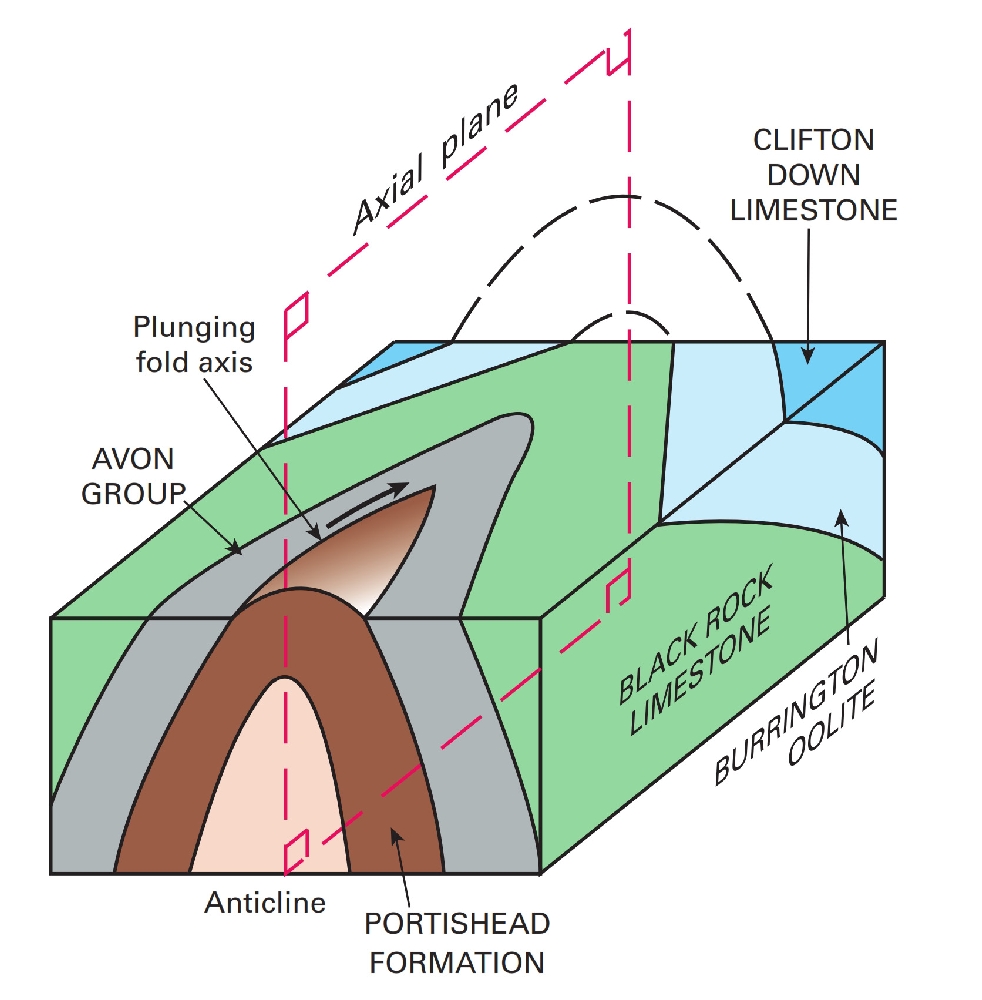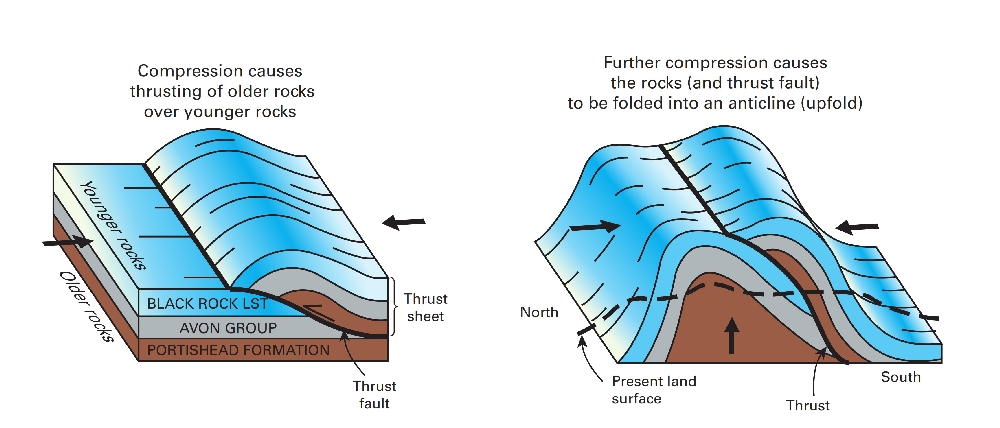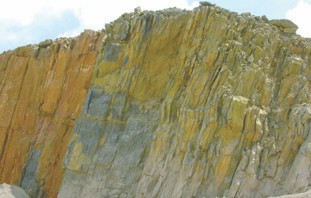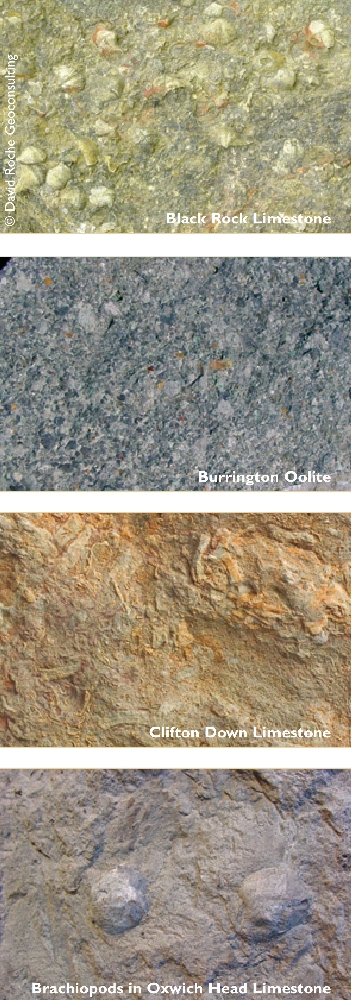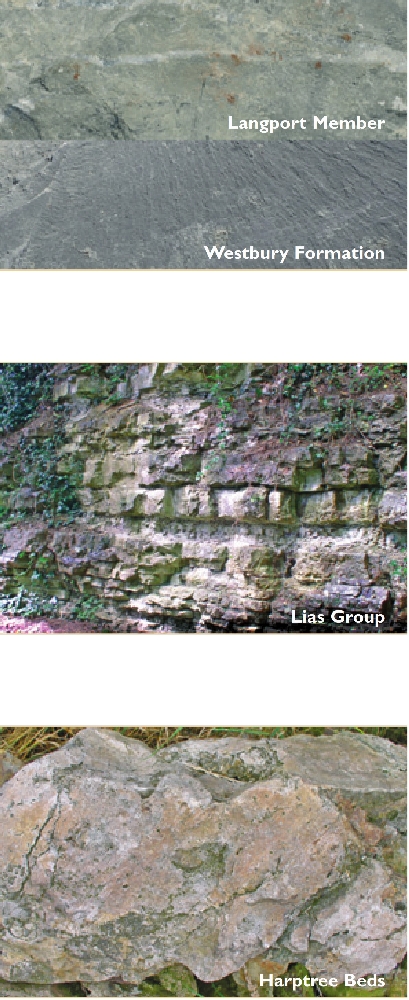Rocks of Mendip
Sedimentary rocks
The western Mendips are made up of sedimentary rocks ranging in age from Devonian to Jurassic. Sedimentary rocks are formed by the accumulation of debris, such as sand and mud or the remains of organisms such as shells, in a range of different environments. Over time sediments are buried and harden into rock, thus forming sandstone, mudstone or limestone, depending on the original sediment; this process is known as diagenesis.
Sediments are usually deposited in layers or beds, which may vary in thickness and character and contain features, such as ripple marks, that are diagnostic of certain environments. A sequence of beds that forms a mappable unit of rock is known as a ‘formation’ and is given a name, for example the
The Mendips are characterised by a wide variety of sedimentary rock types formed in a range of different settings from tropical seas to coal swamps and arid deserts. This section describes the major rock units that can be seen as you explore the area.
The story of the Mendips
The story of the Mendip Hills begins some 416 to 359 million years ago during the Devonian Period. At this time, the Mendip region was part of a landmass lying south of the Equator. Rivers draining mountains to the north deposited a thick sequence of sediments across the area; part of this is preserved as the Portishead Formation.
Tropical seas, corals and limestone
A change in the environment occurred at the beginning of the Carboniferous Period about 359 million years ago when the sea flooded, or transgressed, across the area. Britain lay close to the Equator. Conditions would have been warm with most of the region covered by shallow sea or lagoons. As the sea rose, the muddy limestone and mudstone of the
River deltas, muddy swamps and fossil forests
During the late Carboniferous (327–299 million years ago) huge rivers washed sand and mud into the region. The water flowed across wide river deltas allowing the sediments to settle out as thick layers of sand and mud — now the Quartzitic Sandstone and the Coal Measures. Large areas of swampy tropical forest developed on the deltas. The remains of the forests are preserved as thin coal seams, which contain exquisitely preserved fossil plants and insects. Some of these coal seams were worked in the Somerset Coalfield.
Mountains, rocky ravines and arid deserts
Following the Carboniferous, a major period of uplift and mountain building occurred. The Devonian and Carboniferous rocks were folded into a series of four asymmetric folds known as periclines (a pericline is a type of anticline which plunges at each end, resembling an upturned boat). These four periclines are centered on Blackdown, North Hill, Pen Hill and Beacon Hill. The rocks were also faulted, with thick slices of rock thrust up over younger strata, creating a series of thrust faults (see map-face section through Priddy and Ebbor).
This folding and faulting created a range of steep rugged mountains. During the Triassic (251–200 million years ago) the climate was hot and dry. Occasional storms incised many deep steep-sided ravines or wadis into the flanks of the mountains. The mountain flanks and valleys were buried by material eroded from the mountains which was subsequently cemented by calcite to form the Dolomitic Conglomerate. These slope deposits thin rapidly away from the Mendips, grading into red mudstone — the
Rising seas and the Mendip archipelago
At the start of the Jurassic (200–145 million years ago), the marine transgression continued, at times submerging almost the entire area and leaving only a few areas of land to create the ‘Mendip archipelago’. Limestone accumulated in a series of shallow lagoons, together with beach (littoral) deposits of the Lower Jurassic
Rock types seen in the western Mendips
Devonian rocks
Portishead Formation (Old Red Sandstone)
The Portishead Formation comprises reddish brown sandstone with some conglomerate (pebble beds). The sandstones were deposited by seasonal rivers as channel fills in a desert environment. Cross-bedding and ripple marks can be seen. The Portishead Formation outcrops on Blackdown, North Hill, Pen Hill and Beacon Hill.
Carboniferous rocks
Avon Group (Lower Limestone Shale)
This group consists of interbedded mudstones and thin fossiliferous limestones, which mark the transgression of the sea at the start of the Carboniferous Period. Some of the thin limestone beds are crowded with fragments of crinoids and other fossils that indicate a marine setting. They are well exposed in the East Twin and West Twin valleys at Burrington.
Black Rock Limestone Subgroup
This is a very dark grey, fine-grained fossiliferous limestone. It contains many broken fragments of crinoids (sea lilies) and brachiopods. Black chert nodules are common, as are silicified Spirifer brachiopods. The Black Rock Limestone is particularly well exposed in Burrington Combe.
Burrington Oolite Subgroup
This rock is a light grey oolitic limestone. The rock is composed of many small spherical grains of carbonate known as ooliths. They formed by the deposition of carbonate in concentric layers around a nucleus, rather like a pearl. Oolites form today in warm, supersaturated, shallow, highly agitated marine water, often in areas with strong tidal currents. In eastern Mendip, the Burrington Oolite is locally replaced by the
Clifton Down Limestone Formation
The Clifton Down Limestone consists of dark- grey and black fine-grained muddy limestone, part of which known locally as ‘Chinastone’ because of its resemblance to porcelain. It contains Lithostrotion corals and large Productus brachiopods. It is best seen in Cheddar Gorge. Locally around Cheddar, two separate ‘members’ (the Cheddar Oolite and Cheddar Limestone) can be mapped.
Oxwich Head Limestone Formation
The Oxwich Head Limestone is the youngest part of the Carboniferous Limestone sequence. It consists of grey bioclastic limestone with much crinoid debris and some chert nodules, interbedded with oolitic limestone. This contrasts markedly with the fine-grained limestone of the Clifton Down Formation, which lies beneath it. It is best seen in the crags high
Quartzitic Sandstone and Coal Measures
Overlying the Carboniferous Limestone are coarse red sandstone and grey mudstones with thin coal seams. This marks a change from open marine to terrestrial conditions. The sandstones were deposited in a river delta as it built out into the sea. In western Mendip, these rocks are mostly buried beneath younger strata, but a small patch can be found in Ebbor Gorge. The Coal Measures outcrop more widely around Radstock where the thin coal seams were mined in the North Somerset Coalfield.
Triassic rocks
Dolomitic Conglomerate
This is a coarse-grained rock consisting of a mix of boulders and smaller fragments of Carboniferous Limestone and, less commonly, Portishead Formation, bound together with finer-grained sediment. It is found along the flanks of the Mendips and is often used as a building stone, known locally as ‘Draycott Marble’.
Mercia Mudstone Group
This unit is mostly red mudstone with some siltstone and sandstone beds. The mudstone was deposited as wind-blown dust in a desert with periodic development of temporary lakes caused by flash floods from rain storms. Consequently, these sediments are thin or absent on the Mendip Hills, but are much thicker in the low-lying basins to the north and south. On the flanks of the Mendips, the mudstones either interfinger with the Dolomitic Conglomerate or overlie it. The top of the Mercia Mudstone is a green mudstone known as the
Penarth Group
Above the Mercia Mudstone is the
Jurassic rocks
Lias Group
The
Harptree Beds
Over much of central Mendip the Lower Jurassic rocks have been silicified, and instead of a sequence of limestones and mudstones, the rock has been replaced by chert, a hard flint-like rock. This was caused by silica-rich fluids permeating through the rock after deposition and is related to the lead and zinc mineralisation. The


